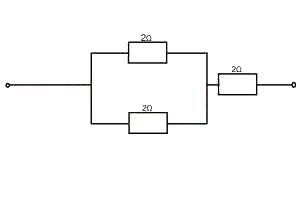
Physics Questions and Answers
If you want to learn more about the nature and properties of matter and energy or you're simply preparing for a Physics exam, these Physics past questions and answers are ideal for you.

If you want to learn more about the nature and properties of matter and energy or you're simply preparing for a Physics exam, these Physics past questions and answers are ideal for you.
30V
40V
300V
400V
Correct answer is C
In general, if a charged particle is accelerated between two metal plates/a region by potential difference V volts, the work done on the charge, given by the product of the charge and the potential difference, is equal to the kinetic energy of the charge
Thus eV = K.E
1.6 x 10-19 x V = 4.8 x 10-17
| ∴ V = | 4.8 x 10-17 |
| 1.6 x 10-19 |
40Ω
20Ω
10Ω
5Ω
Correct answer is B
Let the original length = L1
Let the original resistance = R1 = 5Ω
Let the original resistivity = P1
Let the original area = a1
Let the new length = L2 = 2L1
let the new area = a2 = 1/(2a2)
Let the new resistance = R2
Let the new resistivity = P2
But since the resistivity remains the same,
=> P1 = P2
| ∴ P1 = | R1 a1 |
| _L1 |
| = P2 = | R2 a2 |
| _L2 |
| ∴ | R1 a1 |
| _L1 |
| = | R2 2a1/2 |
| _2L1 |
| => | 5 x a1 |
| _L1 |
| = | R2 x a1 |
| _4L1 |
| ∴R2 = | 5 x a1 x 4L1 |
| _a1 x L1 |
The operation of an optical fibre is based on the principal of
dispersion of light
interference of light
refraction of light
polarization of light
Correct answer is C
No explanation has been provided for this answer.

27W
18W
9W
5W
Correct answer is A
From the above diagram, if each of the resistors can dissipate a maximum of 18W, the from the relation power, P = I2R, the current in the 2Ω series resistor is given by:
I2 = P/R = 18/2 = 9 => I = √9 = 3A
The effective parallel arrangement of the two 2Ω resistors: 1/R = 1/2 + 1/2 = 1Ω
∴ Total resistance in the circuit = 1 + 2 = 3Ω
current flowing the circuit = 3A
∴ Maxi. power = P = I2R = 32 x 3 = 27W
no charge and a zero potential
a positive charge and zero potential
a negative charge and positive potential
a negative charge and a negative potential
Correct answer is D
No explanation has been provided for this answer.